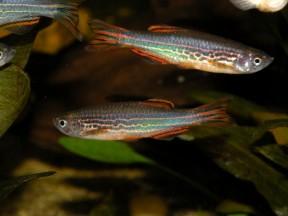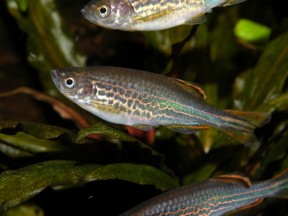Brachydanio kyathit
Orange-Finned 'Danio'
SynonymsTop ↑
Danio kyathit Fang, 1998
Etymology
Brachydanio: from the Ancient Greek βραχύς (brakhús), meaning ‘short’, and Dhani, a Bengalese vernacular term for small, minnow-like cyprinids.
kyathit: the Burmese word for ‘leopard’, given in reference to the species’ colour pattern.
Classification
Order: Cypriniformes Family: Cyprinidae
Distribution
The type series was collected close to the city of Myitkyina, Kachin State, northern Myanmar from upper sections of three tributaries of the Irrawaddy/Ayeyarwaddy River drainage; the Hpa-Lap Chaung (Hpa-Lap stream), Mogaung Chaung and Chindwin Myit (Chindwin River). It has since been recorded from neighbouring Sagaing Division and further west still in Chin State.
Type locality is ‘About 16.5 kilometers northwest of Myitkyina, 25°32’08″N, 97°23’02″E, tributary of Ayeyarwaddy River, Hpa Lap Chaung stream, Myanmar’.
Populations from different localities vary in appearance, some have probably appeared in the trade and one was possibly described as B. quagga in 2009 (see ‘Notes’).
Kachin is one of the world’s great biodiversity hotspots and contains many endemic species although sadly large portions of the area have been decimated due to illegal logging by both Myanmar and neighbouring China.
Habitat
The type locality is a small stream with dense marginal bamboo growth providing a lot of shade.
The water was flowing quite quickly and was clear but slightly brownish in colour with substrates of mud and stones.
Maximum Standard Length
40 – 45 mm.
Aquarium SizeTop ↑
An active species best kept in a tank with base measurements of at least 90 ∗ 30 cm.
Maintenance
Looks particularly effective in a heavily-planted arrangement with a darker substrate, and may appear paler in sparsely-decorated set-ups.
We suggest maintaining it in a well-planted aquarium or set-up designed to resemble a flowing river or stream, with a substrate of variably-sized rocks and gravel and some large water-worn boulders.
Additional powerhead(s) or filter outlets can be used to provide flow but torrent-like conditions should be avoided as small danionins tend to occupy calmer stretches and marginal zones in nature.
Driftwood roots, branches and aquatic plants, with hardy genera such as Microsorum, Bolbitis or Anubias ideal since they can be grown attached to the décor, can also be added.
The aquarium must have a very tightly-fitting cover as members of this genus are accomplished jumpers and can fit through surprisingly small gaps.
Water Conditions
Temperature: In Kachin the air temperature varies between 80°F/26.6°C in summer and 60°F/15.5°C in winter. Under aquarium conditions it seems most comfortable between 16 – 26 °C.
pH: 6.5 – 7.5
Hardness: The water in northern Myanmar is typically soft so aim for somewhere within the range 18 – 90 ppm.
Diet
Almost certain to prey chiefly on insects and their larvae in nature. In the aquarium it’s a largely unfussy feeder and will accept most foods.
A good quality dried product can be used as the staple diet but this should be supplemented with regular meals of small live and frozen fare such as bloodworm, Daphnia, Artemia, etc. in order that the fish develop optimum colouration and conditioning.
Behaviour and CompatibilityTop ↑
This species is very peaceful indeed making it an ideal resident of the well-furnished community tank.
Since it places no special demands in terms of water chemistry it can be combined with many of the most popular fish in the hobby including other small cyprinids as well as tetras, livebearers, rainbowfishes, anabantoids, catfish and loaches.
A community based around fishes from Kachin could also make an interesting display with other species from the area including Celestichthys choprae, Brachydanio tinwini, Pethia erythromycter, P. didi, Acanthocobitis zonalternans, Lepidocephalichthys guntea, Badis corycaeus, and Dario hysginon.
It’s a schooling species by nature and should be maintained in a group of at least 8-10 specimens.
Maintaining it in decent numbers will not only make the fish less nervous but result in a more effective, natural-looking display while males will also exhibit their best colours as they compete with one other for female attention.
Sexual Dimorphism
Sexually mature females are usually rounder-bellied, slightly less colourful and a little larger than males.
The differences are especially clear when the fish are in spawning condition.
Reproduction
Like most small cyprinids this species is an egg-scattering spawner that exhibits no parental care.
That is to say when the fish are in good condition they will spawn often and in a densely-planted, mature aquarium it is possible that small numbers of fry may start to appear without intervention.
However if you want to increase the yield of fry a slightly more controlled approach is required.
The adult group can still be conditioned together but one or more small, say 30-40 litre, containers should also be set up and half-filled with water.
Much of the available space should be filled with a suitable spawning medium such as Java moss, wool mops or a spawning grid.
The water should be of slightly acidic to neutral pH with a temperature towards the upper end of the range suggested above.
An internal power filter can be added initially and this should be positioned so that the flow is directed down the full length of the tank.
When the adult fish are well-conditioned and the females appear full of eggs one or two pairs should then be introduced to each container.
Spawning can be initiated by adding small amounts of cool water every few hours in such a way that the tank is gradually topped up and feeding small amounts of live and frozen foods, or by performing a large (50-60%) water change in the evening.
Several spawning events will probably occur before a female is spent of eggs.
The adults will eat any they find and are best removed once eggs are spotted, and at this point the power filter (if using) should also be switched for a mature sponge-type unit in order to avoid fry being sucked into the mechanism.
Incubation in is temperature-dependant to an extent but usually takes between 24-36 hours with the young free-swimming a few days later.
Initial food should be Artemia nauplii or similar.
NotesTop ↑
According to current thinking B. kyathit has variable body patterning, with the lateral stripes completely solid in some specimens and either wavy or broken into spot-like markings in others.
Fang’s type series was composed entirely of spotted specimens except a single striped paratype which had been collected by Prashad and Mukerji from Kamaing, close to Myitkyina, in 1929 and misidentified as B. rerio.
While this striped form does superficially resemble B. rerio it possesses much longer barbels and red to orange finnage, plus in B. rerio all 5 dark body stripes continue into the caudal-fin and the anal-fin contains more strongly-defined markings.
It was recovered as genetically distinct from the spotted form in a DNA barcode analysis by Collins at al. 2012).
Another similar, striped fish from the Yu River (Chindwin River drainage) has been described as B. quagga (Kullander, Liao & Fang, 2009) but has shorter barbels.
B. kyathit can be distinguished from all other members of the genus by the following combination of characters: presence of 5-7 dark, longitudinal stripes on the side of the body which may be solid or broken into spots (but see above); lateral line incomplete; two pairs of long barbels; the middle body stripe (P stripe), the stripe above it (P+1 stripe) and sometimes the stripe below it (P-1 stripe) are uniformly-pigmented on the caudal peduncle, and extend to the tip of the caudal-fin rays.
At least two similar-looking fishes have been available in the aquarium trade; one, usually sold as ‘Danio sp redfin’, resembles the striped form of B. kyathit but is a smaller fish and the red pigmentation in the fins is comparatively more intense.
The other is also striped with red fins but grows larger; it’s usually labelled as sp. ‘KP01’ or ‘Burmese zebra danio’. It remains unclear whether these are regional variants of B. kyathit or undescribed species.
In recent years it’s become commonplace to refer to the stripes on the body and fins of danionins as follows:
– P stripe: or “pigment stripe” is the central, dark, lateral stripe on the body which extends into the caudal-fin in some species. Stripes above it are numbered P+1, P+2, etc. and those beneath P-1, P-2, P-3.
– A stripe: the central stripe on the anal-fin; the proximal stripe (above it) is A+1 and the distal stripe (beneath) A-1.
– D stripe: The submarginal dorsal-fin stripe.
Following Fang (2003) Brachydanio spp. are characterised by the presence of an A stripe on the anal-fin and two or more P stripes on the caudal, plus some internal characteristics such as enlarged nasal lamellae.
The genus has undergone some significant taxonomic reshuffling in recent years following the publication of a series of phylogenetic studies.
Older, molecular, phylogenies tended to agree that it represented a monophyletic group consisting of two major clades; the ‘Danio devario‘ group containing the larger, deeper-bodied species and the ‘D. rerio‘ clade comprising the smaller, slimmer fish.
However in 2003 Fang conducted a more detailed study based on morphological characters which included members of other related genera, and the results suggested for the first time that the genus Danio as previously considered represents a polyphyletic grouping, i.e., not all members derived from a single common ancestor.
The genus name Devario was suggested for the larger species with Danio being applied only to the smaller fish (with the exception of the type species, D. dangila which can grow to around 89 mm SL). Recent molecular studies by Mayden et al. (2007) and Fang et al. (2009) resulted in further changes, with the latter study considering the genus Danio to be composed of three subclades. These were subsequently split into distinct genera by Kottelat (2013), as follows:
The former species D. erythromicron, D. margaritatus, D. choprae and D. flagrans are grouped together in the revalidated genus Celestichthys Roberts, 2007. These exhibit unique body patterning consisting of vertical bars (C. erythromicron, C. choprae, C. flagrans) or light spots (C. margaritatus) and possess either very short barbels or none at all.
The genus Danio contains only the type species, D. dangila, separated on the basis of its larger size and the shape of the caudal-fin, which in adults is only slightly emarginate or even truncate in shape, a feature it shares only with Tinca tinca (the common tench) among other cyprinids.
The remaining species, of which B. rerio is thought to be the most ancient, are included in the revalidated genus Brachydanio Weber & de Beaufort, 1916.
References
- Fang, F., 1998 - Ichthyological Exploration of Freshwaters 8(3): 273-280
Danio kyathit, a new species of cyprinid species from Myitkyina, northern Myanmar. - Collins R. A., K. F. Armstrong, R. Meier, Y. Yi, S. D. J. Brown, R. H. Cruickshank, S. Keeling, C. Johnston, 2012 - PLoS ONE 7(1): e28381
Barcoding and border biosecurity: identifying cyprinid fishes in the aquarium trade. - Conway, K. W., W.-J. Chen and R. L. Mayden, 2008 - Zootaxa 1686: 1-28
The 'Celestial Pearl danio' is a miniature Danio (s.s) (Ostariophysi: Cyprinidae): evidence from morphology and molecules. - Fang, F., 2003 - Copeia 2003(4): 714-728
Phylogenetic Analysis of the Asian Cyprinid Genus Danio (Teleostei, Cyprinidae). - Fang, F., M. Norén, T. Y. Liao, M. Källersjö and S. O. Kullander, 2009 - Zoologica Scripta 38(1): 1-20
Molecular phylogenetic interrelationships of the south Asian cyprinid genera Danio, Devario and Microrasbora (Teleostei, Cyprinidae, Danioninae). - Kottelat, M., 2013 - The Raffles Bulletin of Zoology Supplement 27: 1-663
The fishes of the inland waters of southeast Asia: a catalogue and core bibiography of the fishes known to occur in freshwaters, mangroves and estuaries. - Mayden, R. L., K. L. Tang, K. W. Conway, J. Freyhof, S. Chamberlain, M. Haskins, L. Schneider, M. Sudkamp, R. M. Wood, M. Agnew, A. Bufalino, Z. Sulaiman, M. Miya, K. Saitoh, S. He, 2007 - Journal of Experimental Zoology, Molecular Development and Evolution 308B: 642–654
Phylogenetic relationships of Danio within the order Cypriniformes: a framework for comparative and evolutionary studies of a model species.











